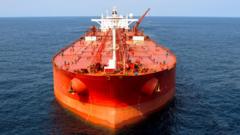Oil prices surged as tensions rise in Middle East following Israel's military actions against Iran, creating fears of supply disruption in an already volatile market.
Global oil prices have seen a significant increase after Israel's announcement of strikes against Iran, marking a dramatic escalation in Middle Eastern tensions. The benchmark Brent crude oil price surged more than 10% at the news, reaching its highest levels since January, with many traders worried that escalating conflict could jeopardize supplies from this energy-rich area.
Shortly after the initial spike, oil prices slightly retreated, yet Brent still traded around $74.47 a barrel, representing a more than 5% increase from the previous day's close. In contrast, oil futures remain over 10% below values seen at the same time last year and significantly lower than the highs of early 2022, which soared above $100 a barrel following geopolitical conflicts.
As oil prices surged, stock markets reacted negatively across Asia and Europe. Japan's Nikkei index fell by 0.9%, and the UK's FTSE 100 dropped by 0.3% during midday trading. US markets mirrored this trend, with the Dow Jones Industrial Average decreasing by 1.5% and the S&P 500 dropping by 0.8%. In response to the growing uncertainty, investors shifted toward so-called "safe haven" assets, including gold, which reached its highest price in two months, climbing 1.2% to $3,423.30 per ounce.
The Israeli Defense Forces reported an Iranian retaliation involving around 100 drones directed at Israel, indicating a potential escalation. Experts warn that energy traders are closely monitoring the situation. "It's a precarious situation that could either de-escalate swiftly, akin to previous strikes, or spiral out into a larger conflict that disrupts Middle Eastern oil supply," said Vandana Hari from Vanda Insights.
Capital Economics analysts predict that if Iran's oil infrastructure is attacked, Brent crude prices could surge to between $80 and $100 a barrel. However, they also suggest that such price increases could incentivize other oil producers to ramp up output, thus containing further inflationary impacts.
Rod Dennis from the RAC cautions that it's premature to determine the direct impact of rising oil prices on consumer petrol costs, noting that this will heavily depend on how retail margins adjust amid changing wholesale prices. In an extreme scenario, Iran could leverage its influence over the Strait of Hormuz, a crucial shipping lane where roughly 20% of global oil passes, potentially disrupting vast quantities of oil exports and exacerbating the current supply crisis.
Saul Kavonic, head of energy research at MST Financial, believes that the market must quickly assess the possibility of escalating tensions within the next few days. As the situation unfolds, traders, consumers, and investors remain on high alert, closely watching for further developments in this volatile geopolitical landscape.
Global oil prices have seen a significant increase after Israel's announcement of strikes against Iran, marking a dramatic escalation in Middle Eastern tensions. The benchmark Brent crude oil price surged more than 10% at the news, reaching its highest levels since January, with many traders worried that escalating conflict could jeopardize supplies from this energy-rich area.
Shortly after the initial spike, oil prices slightly retreated, yet Brent still traded around $74.47 a barrel, representing a more than 5% increase from the previous day's close. In contrast, oil futures remain over 10% below values seen at the same time last year and significantly lower than the highs of early 2022, which soared above $100 a barrel following geopolitical conflicts.
As oil prices surged, stock markets reacted negatively across Asia and Europe. Japan's Nikkei index fell by 0.9%, and the UK's FTSE 100 dropped by 0.3% during midday trading. US markets mirrored this trend, with the Dow Jones Industrial Average decreasing by 1.5% and the S&P 500 dropping by 0.8%. In response to the growing uncertainty, investors shifted toward so-called "safe haven" assets, including gold, which reached its highest price in two months, climbing 1.2% to $3,423.30 per ounce.
The Israeli Defense Forces reported an Iranian retaliation involving around 100 drones directed at Israel, indicating a potential escalation. Experts warn that energy traders are closely monitoring the situation. "It's a precarious situation that could either de-escalate swiftly, akin to previous strikes, or spiral out into a larger conflict that disrupts Middle Eastern oil supply," said Vandana Hari from Vanda Insights.
Capital Economics analysts predict that if Iran's oil infrastructure is attacked, Brent crude prices could surge to between $80 and $100 a barrel. However, they also suggest that such price increases could incentivize other oil producers to ramp up output, thus containing further inflationary impacts.
Rod Dennis from the RAC cautions that it's premature to determine the direct impact of rising oil prices on consumer petrol costs, noting that this will heavily depend on how retail margins adjust amid changing wholesale prices. In an extreme scenario, Iran could leverage its influence over the Strait of Hormuz, a crucial shipping lane where roughly 20% of global oil passes, potentially disrupting vast quantities of oil exports and exacerbating the current supply crisis.
Saul Kavonic, head of energy research at MST Financial, believes that the market must quickly assess the possibility of escalating tensions within the next few days. As the situation unfolds, traders, consumers, and investors remain on high alert, closely watching for further developments in this volatile geopolitical landscape.













